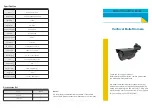
Operating Instructions
6
Network Parameters Table
*
1
Many ISP's intentionally block the port number 80 to guard against network
viruses. If your ISP blocks the port number 80, substitute it to another unused
port number.
*
2
When you use more than one Network Camera with a broadband router, each
Network Camera needs its own port number.
*
3
The Port Forwarding (IP Masquerade) feature needs to be set to the
broadband router. Refer to page 32 in the Operating Instructions.
*
4
Refer to the broadband router's manual.
*
5
When you use a Network Camera in DHCP feature, check [DHCP] and enter
the Host Name if your ISP requires. If you automatically get the address of
Default Gateway and DNS server from DHCP server, you do not need to set up.
*
6
Verify that your ISP supports DHCP. If your ISP supports DHCP, or if you assign a
domain name to the Network Camera, you need to contract and register for DDNS
service. If you set a static global IP address to the Network Camera and the
broadband router, you do not need to register for DDNS service. Refer to page 34
in the Operating Instructions.
It can restrict the transmit bandwidth.
Select from 0.1 to Unlimited Mbit/s.
Max.
Bandwidth
Usage
Parameters
Network Camera Configuration Type
Port No.
IP address
Subnet
Mask
Default
Gateway
DNS
Server 1, 2
DDNS
Check [Static],
and set the
static private
IP address.
192.168.0.253
(default)
255.255.255.0
(default)
Check [Static],
and set the
static global
IP address.*
5
Check [Static],
and set the
static private
IP address.*
4
Set Default
Gateway
address.
You do not
need to set up.
Set DNS server address.
[Type 1]
[Type 2]
[Type 3]
[Type 4]
Set Default
Gateway
address.*
5
Set DNS server
address.*
5
Set the private
IP address of the
broadband router
(on your network),
not of the gateway
of your ISP. *
4
80 (default)*
1
80 (default)
80 (default)
Set the Subnet Mask fitted to your network.
You do not
need to setup.
You do not
need to setup.
*
6
*
6
80 (default)*
1
*
3
*
2


































